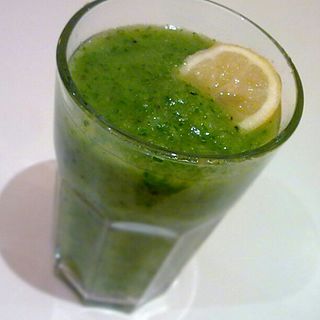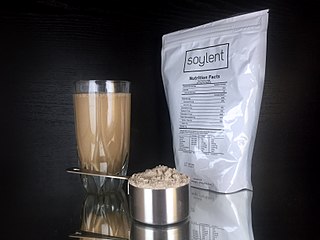Related Research Articles
Dieting is the practice of eating food in a regulated way to decrease, maintain, or increase body weight, or to prevent and treat diseases such as diabetes and obesity. As weight loss depends on calorie intake, different kinds of calorie-reduced diets, such as those emphasising particular macronutrients, have been shown to be no more effective than one another. As weight regain is common, diet success is best predicted by long-term adherence. Regardless, the outcome of a diet can vary widely depending on the individual.

The Atkins diet is a low-carbohydrate fad diet devised by Robert Atkins in the 1970s, marketed with claims that carbohydrate restriction is crucial to weight loss and that the diet offered "a high calorie way to stay thin forever".
Fasting is the abstention from eating and sometimes drinking. From a purely physiological context, "fasting" may refer to the metabolic status of a person who has not eaten overnight, or to the metabolic state achieved after complete digestion and absorption of a meal. Several metabolic adjustments occur during fasting. Some diagnostic tests are used to determine a fasting state. For example, a person is assumed to be fasting once 8–12 hours have elapsed since the last meal. Metabolic changes in the fasting state begin after absorption of a meal.

A fad diet is a diet that becomes popular for a short time, similar to fads in fashion, without being a standard dietary recommendation, and often making unreasonable claims for fast weight loss or health improvements. There is no single definition of what is a fad diet. The term fad diet encompasses a variety of diets with different approaches and evidence bases, and thus different outcomes, advantages, and disadvantages.
The Zone diet is a fad diet emphasizing low-carbohydrate consumption. It was created by Barry Sears, an American biochemist.

The ketogenic diet is a high-fat, adequate-protein, low-carbohydrate mainstream dietary therapy that in medicine is used mainly to treat hard-to-control (refractory) epilepsy in children. The diet forces the body to burn fats rather than carbohydrates.

Weight gain is an increase in body weight. This can involve an increase in muscle mass, fat deposits, excess fluids such as water or other factors. Weight gain can be a symptom of a serious medical condition.
Body for Life (BFL) is a 12-week nutrition and exercise program, and also an annual physique transformation competition. The program utilizes a low-fat high-protein diet. It was created by Bill Phillips, a former competitive bodybuilder and previous owner of EAS, a manufacturer of nutritional supplements. It has been popularized by a bestselling book of the same name.
The Cambridge Diet was a very-low-calorie meal replacement fad diet developed in the 1960s. The diet launched with different versions in the US and the UK. The US version filed for bankruptcy and shut down shortly after the deaths of several dieters. The UK diet has also been known as the Cambridge Weight Plan, but is now known as The 1:1 Diet.

The Grapefruit diet is a short-term fad diet that has existed in the United States since at least the 1930s. There are variations on the diet, although it generally consists of eating one grapefruit at each meal, along with meat, eggs, other foods that are rich in fat and protein, and certain vegetables. Sugar, fruits, sweet vegetables, grains and starchy vegetables are to be avoided. The grapefruit diet is thus a low-carbohydrate diet. A typical breakfast menu usually includes bacon and eggs. The diet is based on the claim that grapefruit has a fat-burning enzyme or similar property. The grapefruit diet does not require exercise. The grapefruit diet lasts for 10 to 12 days followed by 2 days off.

A very-low-calorie diet (VLCD), also known as semistarvation diet and crash diet, is a type of diet with very or extremely low daily food energy consumption. Often described as a fad diet, it is defined as a diet of 800 kilocalories (3,300 kJ) per day or less. Modern medically supervised VLCDs use total meal replacements, with regulated formulations in Europe and Canada which contain the recommended daily requirements for vitamins, minerals, trace elements, fatty acids, protein and electrolyte balance. Carbohydrates may be entirely absent, or substituted for a portion of the protein; this choice has important metabolic effects. Medically supervised VLCDs have specific therapeutic applications for rapid weight loss, such as in morbid obesity or before a bariatric surgery, using formulated, nutritionally complete liquid meals containing 800 kilocalories or less per day for a maximum of 12 weeks.
Intermittent fasting, also known as intermittent energy restriction, is any of various meal timing schedules that cycle between voluntary fasting and non-fasting over a given period. Methods of intermittent fasting include alternate-day fasting, periodic fasting, and daily time-restricted feeding.

The Shangri-La Diet is both the name of a book by the psychologist Seth Roberts, a professor at Tsinghua University and professor emeritus at UC Berkeley, and the name of the diet that the book advocates. The book discusses consuming 100–400 calories per day in a flavorless food such as extra light olive oil one hour outside of mealtimes as a method of appetite suppression leading to weight loss.
The South Beach Diet is a popular fad diet developed by Arthur Agatston and promoted in a best-selling 2003 book. It emphasizes eating food with a low glycemic index, and categorizes carbohydrates and fats as "good" or "bad". Like other fad diets, it may have elements which are generally recognized as sensible, but it promises benefits not backed by supporting evidence or sound science.

A meal replacement is a drink, bar, soup, etc. intended as a substitute for a solid food, usually with controlled quantities of calories and nutrients. Some drinks come in powdered form or pre-mixed health shakes that can be cheaper than solid foods with identical health qualities. Medically prescribed meal replacement drinks include the body's necessary vitamins and minerals. Bodybuilders sometimes use meal replacements, not formulated for weight loss, to save food preparation time when eating 5-6 meals a day.
Charles Joseph Genster was an American business executive at the nutrition company Mead Johnson who oversaw the development and marketing of Metrecal, a liquid diet drink that became a weight loss craze in the early 1960s.

Jorge Cruise is a Mexican author, fitness trainer and proponent of intermittent fasting and low-carbohydrate dieting. He is the author of The Cruise Control Diet (2019) as well as books on The New York Times bestseller list: The 100 (2013), The Belly Fat Cure (2010), Body at Home (2009), The 12-Second Sequence (2009), The 3-Hour Diet (2006), and 8 Minutes in the Morning (2002).
A low-quantity diet is a weight-loss diet that restricts the amount of food eaten, rather than caloric intake or the type of food eaten. These diets are based on the claim that the amount of food eaten is the primary factor in weight-loss. Typically, low-quantity diets focus on restricting the number of bites eaten in a day as a way to achieve portion control.
Weight Watchers or WW is a commercial program for weight loss based on a point system, meals replacement and counseling.
References
- ↑ Cookie Monsters Broward-Palm Beach New Times. 17 Apr 2008.
- ↑ Bite Fight Forbes. 17 Nov 2008.
- ↑ Bix, Cynthia Overbeck. (2015). Fad Mania!: A History of American Crazes. Twenty-First Century Books. p. 43. ISBN 978-1-4677-1034-3
- ↑ "The Cookie Diet". ABC News. Retrieved December 16, 2019.